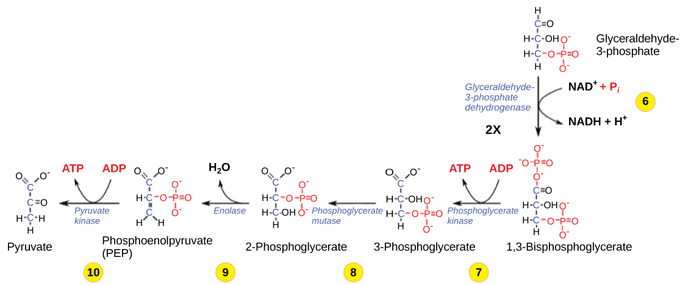Atp Made During Glycolysis Is Generated by
ATP is generated by substrate-level phosphorylation by high-energy compounds such as 13-bisphosphoglycerate and phosphoenolpyruvateGlycolysis is used by all cells in the body for energy generation. The ATP made during glycolysis is generated by substrate-level phosphorylation.
In glycolysis 4 ATP are generated through substrate-level phosphorylation.
. The energy payoff phase of glycolysis consists of five additional steps and results in the formation of four ATP two NADH H and two pyruvate molecules. Substrate-level phosphorylation is a type of metabolic reaction that results in the formation of Adenosine Triphosphate ATP or Guanosine Triphosphate GTP by the direct transfer and donation of a phosphoiy1 PO_3 group to Adenosine Diphosphate ADP or Guanosine Diphosphate GDP from a phosphorylated reactive intermediate. Biology textbooks often state that 38 ATP molecules can be made per oxidized glucose molecule during cellular respiration 2 from glycolysis 2 from the Krebs cycle and about 34 from the electron transport system.
Most of the ATP made during cellular respiration is generated by. Hence net ATP during glycolysis 4-2 2. Most of the ATP produced by aerobic cellular respiration is made by oxidative phosphorylation.
During glycolysis ATP is formed at two stages because of direct transfer of phosphoryl group to ADP. The ATP made during glycolysis is generated by the process of. View the full answer.
Biology questions and answers. The final product of glycolysis is pyruvate in aerobic settings and lactate in anaerobic conditions. Apart from the 4 ATP 2NADH are also produced during the glycolysis which is used during the oxidative phosphorylation and produce 4-6 ATP.
Glycolysis is a complex enzyme-controlled set of reactions. This pathway is a step-wise process in which 2 ATPs are consumed in preparatory stage and 4 ATPs are released in payoff stage as shown below. Biology textbooks often state that 38 ATP molecules can be made per oxidized glucose molecule during cellular respiration 2 from glycolysis 2 from the Krebs cycle and about 34 from the electron transport system.
The pathway of the breakdown of glucose into pyruvic acid is termed as glycolysis. In glycolysis cycle nadh2 is produced when glyceraldehyde is converted to 13 Bisphosphogycerate where nad becomes nadh2 enter electron transfer chain produces 3 atp. ATP released in payoff stage 4.
Substrate level phosphorylation c. The oxygen consumed during cellular respiration is involved directly in which process or. For example- 13-bisphosphoglycerate ADP -----3-phosphoglycerate ATP Oxidation of.
Substrate level phosphorylation is the process by which ATP is produced from the transfer of a phosphate group from a substrate molecule in a metabolic pathway. In glycolysis substrate level. 94 The ATP made during glycolysis is generated by A oxidation of NADH to NAD B substrate-level phosphorylation.
This is called substrate level phosphorylation. 10 The ATP made during glycolysis is generated by A substrate-level phosphorylation. In substrate-level phoshorylation ATP is produced by the addition of a phosphate group to ADP by a phosphorylated intermediate formed during the reaction not from any inorganic molecule like in the case of oxidative phosphorylation.
The ATP produced during glycolysis is generated by which of the following. For example when 13 phosphoglycerate converts into 3. Transfer of phosphate from glucose-phosphate to ADP.
The formation of ATP directly during a chemical reaction is called substrate level phosphorylation. O substrate-level phosphorylation O noncyclic photophosphorylation O photophosphorylation O conversion of NADH to NAD O electron transport chain Light energy varies in energy depending on the of electromagnetic radiation. ATP consumed in preparatory stage 2.
Since two molecules of gylceraldehyde gets converted to 2 molecules of 13 bisphosphoglycerate hence 2 nadh2 are produced so 236 atp molecules are produced in this step. During the cleavage stage of glycolysis fructose-1 6 biphosphate is broken down into. The process of glycolysis only produces two ATP while all the rest are produced during the electron transport chain.
Direct synthesis of ATP during the citric acid cycle. The electron transport chain b. When formation of ATP happens by direct transfer of a phosphoryl PO_3 group to ADP from a phosphorylated reactive intermediate.
During glycolysis atp is produced by. In a eukaryotic cell the process of cellular respiration can metabolize one molecule of glucose into 30 to 32 ATP. Most of the ATP produced by aerobic cellular respiration is made by oxidative phosphorylation.
2 ATP during Glycolysis net gain 2 ATP during Citric Acid Cycle 28 ATP during ETC from the NADHFADH2 Fermentation Used when there is no oxygen it. 6 most of the atp made during cellular respiration is. So ATP made during glycolysis is generated by substrate-level phosphorylation as ATP is produced by direct addition of phosphoryl group from intermediates.

Glycolysis Cellular Respiration Biology Article Khan Academy
How Much Atp Is In The Glycolysis Cycle Quora
How Do We Get 4 Atp Molecules In Glycolysis Quora
The Atp Made During Glycolysis Is Generated By What Quora
The Atp Made During Glycolysis Is Generated By What Quora
2 27 Glycolysis Biology Libretexts
The Atp Made During Glycolysis Is Generated By What Quora
4 10 Cellular Respiration Human Biology

How Many Atp Are Produced In Glycolysis And Tca Cycle Byju S Neet
What Are The Molecules That Consume Atp During The Energy Investment Phase In Glycolysis Quora

How Many Atps Does Glycolysis Produce Youtube
How Do We Get 4 Atp Molecules In Glycolysis Quora







Comments
Post a Comment